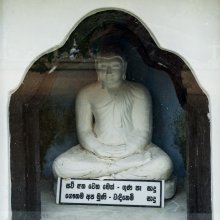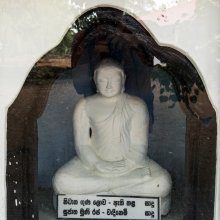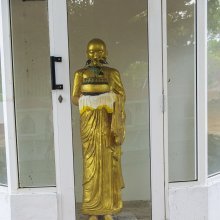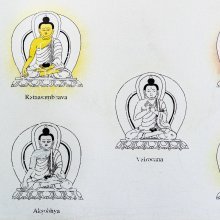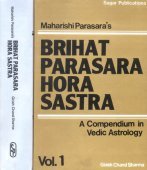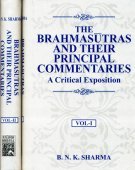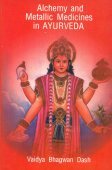Guna, Guṇa, Gūna: 57 definitions
Introduction:
Guna means something in Hinduism, Sanskrit, Jainism, Prakrit, Buddhism, Pali, the history of ancient India, Marathi, Hindi, biology. If you want to know the exact meaning, history, etymology or English translation of this term then check out the descriptions on this page. Add your comment or reference to a book if you want to contribute to this summary article.
Images (photo gallery)
In Hinduism
Vyakarana (Sanskrit grammar)
Source: archive.org: Uṇādi-Sūtras In The Sanskrit Grammatical TraditionGuṇa (गुण).—One of the technical terms which have been used in the uṇādi-sūtras;—Guṇa “denotes a degree of a vowel”. Pāṇini has enumerated the vowels which can be called guṇa. They are short ‘a’, ‘e’, and ‘o’.
Source: WikiPedia: Sanskrit grammarGuna refers to a set of normal-length vowels that are less reduced than the basic set (in modern terms, the zero grade), but more reduced than the vṛddhi vowels (in modern terms, the lengthened grade). As an example, ṛ, i, u are basic (zero-grade) vowels, with corresponding guṇa (full-grade) vowels ar, e, o and vṛddhi (lengthened-grade) vowels ār, ai, au. (This is more understandable once it is realized that, at an earlier stage of development, Sanskrit e and o were ai and au, and Sanskrit ai and au were āi and āu.) Guna is corresponds to what is now termed the full grade in Indo-European ablaut. Another orthography and phonology concept related to Guna is Briddhi.
Source: Shodhganga: Vaiyākaraṇabhūṣaṇasāra: a critical studyGuṇa (गुण).—Attribute; the second out of the three degrees of a vowel, namely the primary degree, guṇa degree and vṛddhi degree.
Source: Wikisource: A dictionary of Sanskrit grammar1) Guṇa (गुण).—Degree of a vowel; vocalic degree, the second out of the three degrees of a vowel viz. primary degree, guna degree and vrddhi degree e.g. इ, ए (i, e) and ऐ (ai) or उ, ओ (u, o) and औ. अ (a) is given as a guna of अ; but regarding अ (a) also,three degrees can be stated अ, अ (a, a) and आ. In the Pratisakhya and Nirukta ए (e) is called गुण (guṇa) or even गुणागम (guṇāgama) but no definiti6n is given ; cf. गुणागमादेतन-भावि चेतन (guṇāgamādetana-bhāvi cetana) R.Pr.XI.6;शेवम् इति विभीषि-तगुणः। शेवमित्यपि भवति (śevam iti vibhīṣi-taguṇaḥ| śevamityapi bhavati) Nir.X.17:
2) Guṇa.—The properties of phonetic elements or letters such as श्वास,नाद (śvāsa, nāda) etc.: cf.R. Pr. Ch.XIII :
3) Guṇa.—Secondary, subordinate;cf. शेषः,अङ्गं, गुणः इति समानार्थाः (śeṣaḥ, aṅgaṃ, guṇaḥ iti samānārthāḥ) Durgācārya on Nir. I.12:
4) Guṇa.—Properties residing in a substance just as whiteness, etc. in a garment which are different from the substance (द्रव्य (dravya)). The word गुण (guṇa) is explained by quotations from ancient grammarians in the Maha bhasya as सत्वे निविशते (satve niviśate)sपैति पृथग्जातिषु दृश्यते । आघेयश्चाक्रियाजश्च सो (paiti pṛthagjātiṣu dṛśyate | āgheyaścākriyājaśca so)Sसत्त्वप्रकृतिर्गुणः ॥ अपर आह । उपैत्यन्यज्जहात्यन्यद् दृष्टो द्रव्यान्तरेष्वपि। वाचकः सर्वलिङ्गानां द्रव्यादन्यो गुणः स्मृतः (sattvaprakṛtirguṇaḥ || apara āha | upaityanyajjahātyanyad dṛṣṭo dravyāntareṣvapi| vācakaḥ sarvaliṅgānāṃ dravyādanyo guṇaḥ smṛtaḥ) ; M. Bh. on IV.1.44;cf also शब्दस्पर्श-रूपरसगन्धा गुणास्ततोन्यद् द्रव्यम् (śabdasparśa-rūparasagandhā guṇāstatonyad dravyam),M.Bh.on V.1.119
5) Guṇa.—Properties of letters like उदात्तत्व, अनुदात्तत्व, स्वरितत्व, ह्र्स्व-त्व, दीर्घत्व, प्लुतत्व, आनुनासिक्य (udāttatva, anudāttatva, svaritatva, hrsva-tva, dīrghatva, plutatva, ānunāsikya) etc.; cf. भेदकत्वाद् गुणस्य । आनुनासिक्यं नाम गुणः (bhedakatvād guṇasya | ānunāsikyaṃ nāma guṇaḥ) M. Bh. on I.1.1.. Vart, 13:
6) Guṇa.—Determinant cf भवति बहुव्रीहौ तद्गुणसंवि-ज्ञानमपि (bhavati bahuvrīhau tadguṇasaṃvi-jñānamapi) M. Bh. on P. I. 1.27;
7) Guṇa.—Technical term in Panini's grarnmar standing for the vowels अ, ए (a, e) and ओ (o), cf. अदेङ्गुणः (adeṅguṇaḥ) P.I.1.2. For the various shades of the meaning of the word गुण (guṇa), see Mahabhasya on V.1.119. " गुणशब्दोयं बह्वर्थः । अस्त्येव समेष्ववयवेषु वर्तते । (guṇaśabdoyaṃ bahvarthaḥ | astyeva sameṣvavayaveṣu vartate |) ...... चर्चागुणांश्च । (carcāguṇāṃśca |)

Vyakarana (व्याकरण, vyākaraṇa) refers to Sanskrit grammar and represents one of the six additional sciences (vedanga) to be studied along with the Vedas. Vyakarana concerns itself with the rules of Sanskrit grammar and linguistic analysis in order to establish the correct context of words and sentences.
Ayurveda (science of life)
Source: Wisdom Library: Āyurveda and botany1) Guṇa (गुण, “quality”).—One of the six padārtha (or ‘basic categories’) which should be known to every Physician if he wants to understand the science of life.
2) Guṇa is a Sanskrit technical term (used in Āurveda) referring a multiplier of a particular quantity, for example, two guṇas of the weight of a stone= two times the weight of that stone.
Source: Google Books: Essentials of AyurvedaGuṇa (गुण) is dependent inherently on dravya and is asamavāyī-kāraṇa (‘of an effect’). It appears in dravy after a moment of the latter’s emergence.
Source: gurumukhi.ru: Ayurveda glossary of termsGuṇa (गुण):—Properties of a substance; present in the substance as a coinherent factor to perform a definite set of actions; might be physical, chemical, pharmacological, etc. but mainly pertains to the pharmacological properties.
Source: National Mission for Manuscripts: Traditional Medicine System in IndiaGuṇa (गुण, “quality”) refers to the “properties and qualities of drugs” and represents one of the six divisions of dravya (drugs).—The drug/dravya, if is properly used it is equivalent to amṛta (nectar) and if improperly used it is like viṣa (poison). According to Āyurveda, dravya or drug is comprised of rasa (taste), guṇa (properties and qualities), vīrya (potency), vipāka (post-digestive-taste), prabhāva (serendipity—specific effect of a drug) and karma (targeted action of a drug).
Guṇas (properties and qualities of drugs/dravya) are forty-one in number. It includes twenty śārīrika-guṇas which are present in medicines also.

Āyurveda (आयुर्वेद, ayurveda) is a branch of Indian science dealing with medicine, herbalism, taxology, anatomy, surgery, alchemy and related topics. Traditional practice of Āyurveda in ancient India dates back to at least the first millenium BC. Literature is commonly written in Sanskrit using various poetic metres.
Purana and Itihasa (epic history)
Source: archive.org: Puranic EncyclopediaGuṇa (गुण).—See under Pattu (Ten).
Source: archive.org: Shiva Purana - English TranslationGuṇa (गुण) refers to the three deities (Viṣṇu, Rudra and Brahmā), according to the Śivapurāṇa 2.1.16:—“Śiva manifested himself in three ways in the form of Vaikuṇṭha (Viṣṇu) born of the left limb (vāmāṅga), in my form (of Brahmā) born of the right limb (dakṣiṇāṅga) and in the form of Rudra born of the heart (hṛdaya). Viṣṇu, Rudra and I [viz., Brahmā] represent the three guṇas. Śiva is free from guṇas. He is the supreme Brahman, the undecaying. Viṣṇu is of sattva attribute, I (Brahmā) am of rajas attribute and Rudra is of tamas attribute. This is only in view of the activities in the world. But in fact and in name it is otherwise”.
Note: From the Cosmic Egg agitated by the three Guṇas—sattva, rajas and tamas, the three deities came into existence. The Purāṇas call them Brahmā, Viṣṇu and Śiva and assign the functions of creation, existence and dissolution to each respectively. Compare Devi-bhāgavata-purāṇa 1.8.2-4. The statement about the three qualities sattva, rajas and tamas manifested as the three Devas is the concensus of the entire Pauranic lore. Compare Liṅga-purāṇa. The Vedas trace the origin of the Trinity to the Brahman, the Śaivas to Maheśvara and the Bhāgavatas to Mahāviṣṇu.
Source: Cologne Digital Sanskrit Dictionaries: The Purana IndexGuṇa (गुण).—Three kinds of persons according to their nature; hence Guṇatrayam; satva prakṛti, rājasa prakṛti and tāmasa prakrti. Their different characteristics. A muni serves satva and conquers rajas and tamas.1 If the three states are normal it is prakṛti, pradhāna or avyakta. If in a condition of agitation, three deities Brahma, Viṣṇu and Śiva are the result.2 Twelve qualities;3 twenty-six in number; yoga, sāmkhya, tapas, vidyā, vidhi, kriyā, ṛtam, satyam, ahiṃsā, dhyānam, sānti, avidyā, mati, dhṛti, kānti, smṛti, medha, lajjā, śuddhi, sarasvati, tuṣti, puṣti etc., all in Brahmā.4

The Purana (पुराण, purāṇas) refers to Sanskrit literature preserving ancient India’s vast cultural history, including historical legends, religious ceremonies, various arts and sciences. The eighteen mahapuranas total over 400,000 shlokas (metrical couplets) and date to at least several centuries BCE.
Samkhya (school of philosophy)
Source: Wikipedia: SamkhyaGuṇa (गुण).—In Samkhya philosophy, there are three major guṇas that serve as the fundamental operating principles or “tendencies” of prakṛti (universal nature) which are called:
- sattva-guṇa, (associated with creation (sattva))
- rajas-guṇa, (associated with preservation (rajas))
- and tamas-guṇa. (associated with destruction (tamas))
Guṇa (गुण, “quality”).—The Sāṃkhya system uses the term guṇa in the sense of the constituent elements of the primordial matter called prakṛti. Prakṛti is consisted of three guṇas, viz.,
- sattva (goodness),
- rajas (passion),
- tamas (darkness).
These guṇas are not perceptible but inferred from the existence of the things.
Sattva is the element of the prakṛti and its nature is pleasure, light and bright. The manifestation of objects in jñāna, the mind, the knowledge, the reflection of light, the reflection in mirror all are happened due to sattvaguṇa. The principle of activity of the objects is known as rajas. It has always movement and it makes other things move. It is possessor of both cala (mobile) and upaṣṭambhaka (stimulating). Fire spreads, the wind blows, the senses follow their objects, the mind feels pain, all these are happened due to the rajas. It helps sattva and tamas to perform their action. Tamas is inactive and it is opposite of sattva. Tamas is guru (heavy) and vāraṇaka (manifestless). Tamas becomes opposed in the motion of things and in the principle of rajas. It causes sleep, drowsiness and laziness through resisting our activity.

Samkhya (सांख्य, Sāṃkhya) is a dualistic school of Hindu philosophy (astika) and is closeley related to the Yoga school. Samkhya philosophy accepts three pramanas (‘proofs’) only as valid means of gaining knowledge. Another important concept is their theory of evolution, revolving around prakriti (matter) and purusha (consciousness).
Vaisheshika (school of philosophy)
Source: Wisdom Library: VaiśeṣikaGuṇa (गुण, “qualities”) is one of the seven accepted categories of padārtha (“metaphysical correlate”), according to the Vaiśeṣika-sūtras. These padārthas represent everything that exists which can be cognized and named. Together with their subdivisions, they attempt to explain the nature of the universe and the existence of living beings.
Source: Wikipedia: VaisheshikaGuṇa (गुण, “quality”): The Vaiśeṣika Sūtra mentions 17 guṇas (qualities), to which Praśastapāda added another 7. While a substance is capable of existing independently by itself, a guṇa (quality) cannot exist so.
The original 17 guṇas (qualities) are,
- rūpa (colour),
- rasa (taste),
- gandha (smell),
- sparśa (touch),
- saṃkhyā (number),
- parimāṇa (size/dimension/quantity),
- pṛthaktva (individuality),
- saṃyoga (conjunction/accompaniments),
- vibhāga (disjunction),
- paratva (priority),
- aparatva (posteriority),
- buddhi (knowledge),
- sukha (pleasure),
- duḥkha (pain),
- icchā (desire),
- dveṣa (aversion)
- and prayatna (effort).
To these Praśastapāda added
- gurutva (heaviness),
- dravatva (fluidity),
- sneha (viscosity),
- dharma (merit),
- adharma (demerit),
- śabda (sound)
- and saṃkāsra (faculty).
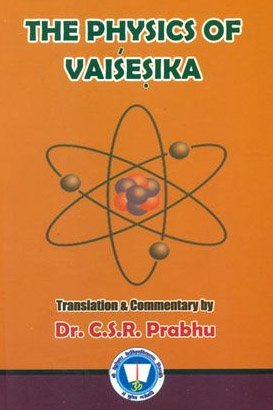
Vaisheshika (वैशेषिक, vaiśeṣika) refers to a school of orthodox Hindu philosophy (astika), drawing its subject-matter from the Upanishads. Vaisheshika deals with subjects such as logic, epistemology, philosophy and expounds concepts similar to Buddhism in nature
Natyashastra (theatrics and dramaturgy)
Source: Wisdom Library: Nāṭya-śāstraGuṇa (गुण) refers to the ten “merits” in a poetical work (kāvya), accoridng to the Nāṭyaśāstra chapter 17. They are opposed by the ten doṣas (‘faults’).
The following are defined as the ten merits (guṇa):
- śleṣa (synthesis),
- prasāda (perspicuity),
- samatā (smoothness),
- samādhi (concentration),
- mādhurya (sweetness),
- ojas (grandeur)
- saukumārya (agreeableness),
- artha-vyakti (directness of expression),
- udāra or udāratā (exaltedness),
- kānti (loveliness).
Guṇa (गुण, “quality”) (or merit) is an important characteristic feature of a poem. The Sāhityadarpaṇa holds that guṇa or excellences are to rasa or flavour, the essence of poetry, what heroism and the like are to soul. Viśvanātha writes in the commentary that as heroism and the like are designated by the term merit, in as much as they cause the exaltation of the soul viewed essentially, so in like manner, are sweetness and the like, which are the qualities or particular modes of flavour, the essence of poetry. It is these attributes of flavour that constitute the claim to the designation of poetry, of a composition communicating its essence, viz. relish.
Regarding the quantity of the guṇas, Bharata states that there are ten guṇas viz. Śleṣa, Prasāda, Samatā, Samādhi, Mādhurya, Ojaḥ, Saukumārya, Arthavyakti, Udāratā and Kānti. Daṇḍin also accepts that the ten guṇas are the life of Vaidarbhīrīti. Vāmana refers to these ten guṇas. Howevere, Udbhaṭa, in his Kāvyālaṃkārasārasaṃgraha, mentions only about three guṇas. Viśvanātha too states that there are three guṇas viz. Mādhurya, Ojaḥ and Prasāda. They are the cause of excellence to the rasa. Mammaṭa is, also of the opinion that the guṇas are three in number, not ten as stated by Vāmana and others.

Natyashastra (नाट्यशास्त्र, nāṭyaśāstra) refers to both the ancient Indian tradition (shastra) of performing arts, (natya—theatrics, drama, dance, music), as well as the name of a Sanskrit work dealing with these subjects. It also teaches the rules for composing Dramatic plays (nataka), construction and performance of Theater, and Poetic works (kavya).
Kavya (poetry)
Source: Shodhganga: A critical appreciation of soddhalas udayasundarikathaGuṇa (गुण).—Vāmana speaks of ten guṇas of word and the same ten guṇas of sense viz.
- (ojas) strength,
- (prasāda) clarity,
- (śleṣa) firm structure,
- (samatā) sameness of evenness of sound,
- (samādhi) metaphorical expression,
- (mādhurya) sweetness,
- (saukumārya) gentleness,
- (udāratā) elavatian,
- (arthavyakti) perspeouity,
- and (kānti) beauty.
Daṇḍin mentions ten guṇas under the same names, hut makes no difference between guṇas of words and those of sense.

Kavya (काव्य, kavya) refers to Sanskrit poetry, a popular ancient Indian tradition of literature. There have been many Sanskrit poets over the ages, hailing from ancient India and beyond. This topic includes mahakavya, or ‘epic poetry’ and natya, or ‘dramatic poetry’.
Kavyashastra (science of poetry)
Source: Shodhganga: The Kavyavilasa of Ciranjiva Bhattacarya (kavyashastra)Guṇa (गुण, “merits”) refers to “poetic merits” as opposed to doṣa (poetic faults), and are ten in number. They are—
- śleṣa,
- prasāda,
- samatā,
- mādhurya,
- sukumāratā,
- arthavyakti,
- udāratva,
- ojas,
- kānti,
- samādhi.
These guṇas may be divided into two types—merits relating to sound (śabdaguṇas) and merits relating to sense (arthaguṇas). So these are twenty in number and this has been firstly pointed out by Vāmana.

Kavyashastra (काव्यशास्त्र, kāvyaśāstra) refers to the ancient Indian tradition of poetry (kavya). Canonical literature (shastra) of the includes encyclopedic manuals dealing with prosody, rhetoric and various other guidelines serving to teach the poet how to compose literature.
Nyaya (school of philosophy)
Source: Shodhganga: A study of Nyāya-vaiśeṣika categoriesGuṇa (गुण, “quality”).—Among the seven categories (padārtha) of the Nyāya-Vaiśeṣika system the second category is guṇa (quality). The English term ‘quality’ used in western philosophy does not bear the same meaning as in the Nyāya-Vaiśeṣika philosophy. According to the western philosophers, the qualities are repeatable properties but according to the Nyāya-Vaiśeṣika guṇa is not a repeatable property.
Kaṇāda (Vaiśeṣikadarśana with Praśastapādabhāṣya) defines guṇa thus: quality has the genus of qualityness (guṇatva), it inheres in a dravya and it is qualityless and actionless. Guṇa cannot be self-existent, it is a dependent category. Existence of a quality depends upon a substance. Quality remains in a substance; it cannot inhere in a quality. Therefore, a quality is defined as qualityless. A karma (action) also inheres in a dravya but it is qualityless. Karma is cause of conjunction and disjunction, but guṇa is not cause of conjunction and disjunction. So, there is difference between guṇa and karma.
Kaṇāda mentions seventeen guṇas viz.,
- rūpa (colour),
- rasa (taste),
- gandha (smell),
- sparśa (touch),
- saṃkhyā (number),
- parimāṇa (size),
- pṛthaktva (individuality),
- saṃyoga (conjunction),
- vibhāga (disjunction),
- paratva (priority),
- aparatva (posteriority),
- buddhi (knowledge),
- sukha (pleasure),
- duḥkha (pain),
- icchā (desire),
- dveṣa (aversion),
- prayatna (effort),
Praśastapāda adds seven more guṇas to these seventeen, which are:—
- gurutva (heaviness)
- dravatva (fluidity),
- sneha (viscidity),
- dharma (merit),
- adharma (demerit),
- śabda (sound),
- saṃskāra (tendency),
All the modern works on Nyāya-Vaiśeṣika accepts twenty four guṇas. Some philosophers add some more guṇas to the above mentioned twentyfour guṇas which are laghutva, mṛdutva, kaṭhinatva. Annaṃbhaṭṭa argues that it is not possible to consider these as separate qualities. Because laghutva, is the negation of gurutva, while, mṛdutva and kaṭhinatva are different degrees of conjunction of the parts. So, there are only twenty-four qualities.

Nyaya (न्याय, nyaya) refers to a school of Hindu philosophy (astika), drawing its subject-matter from the Upanishads. The Nyaya philosophy is known for its theories on logic, methodology and epistemology, however, it is closely related with Vaisheshika in terms of metaphysics.
Mīmāṃsā (school of philosophy)
Source: Shodhganga: A study of Nyāya-vaiśeṣika categories (mimamsa)Guṇa (गुण, “quality”).—According to the Mīmāṃsakas, the word guṇa is used in different senses, sometimes it is used in the sense of a “quality” and sometimes in the general sense of “something”. Sometimes it is used in the sense of literary merit and also in the general sense of a good feature.

Mimamsa (मीमांसा, mīmāṃsā) refers to one of the six orthodox Hindu schools of philosophy, emphasizing the nature of dharma and the philosophy of language. The literature in this school is also known for its in-depth study of ritual actions and social duties.
Vaishnavism (Vaishava dharma)
Source: Pure Bhakti: Bhagavad-gita (4th edition)Guṇa (गुण) refers to “binding force. The three qualities of material nature bind the living entity. There are three guṇas: goodness (sattva), passion (rajas) and darkness, or ignorance (tamas). Literally, ‘rope’ (See Chapter 14)”. (cf. Glossary page from Śrīmad-Bhagavad-Gītā).
Source: Pure Bhakti: Brhad BhagavatamrtamGuṇa (गुण) refers to:—Quality; modes of material nature: goodness, passion, and ignorance. (cf. Glossary page from Śrī Bṛhad-bhāgavatāmṛta).
Source: Prabhupada Books: Sri Caitanya CaritamrtaGuṇa (गुण) or Guṇāvatāra refers to “incarnations that control the material qualities”, according to the Śrī Caitanya Caritāmṛta 2.20.246 (“The Science of the Absolute Truth”).—Accordingly, “There are incarnations that control the material qualities [guṇa-avatāras], incarnations who appear during the reign of each Manu [manvantara-avatāras], incarnations in different millenniums [yuga-avatāras] and incarnations of empowered living entities [śaktyāveśa-avatāras]”.

Vaishnava (वैष्णव, vaiṣṇava) or vaishnavism (vaiṣṇavism) represents a tradition of Hinduism worshipping Vishnu as the supreme Lord. Similar to the Shaktism and Shaivism traditions, Vaishnavism also developed as an individual movement, famous for its exposition of the dashavatara (‘ten avatars of Vishnu’).
Shaivism (Shaiva philosophy)
Source: Brill: Śaivism and the Tantric Traditions1) Guṇa (गुण) [=Guṇatā?] refers to an “attribute”, according to the Īśvarapratyabhijñākārikā 3.2.11.—Accordingly, “And this Awareness-principle, consisting of [unlimited] Agency (kartṛtā-maya), [becomes] limited—[though] it is strengthened by partial agency—abiding as a [mere] attribute (guṇatā) in a person whose [habitual] nature is unconscious, [identifying as he does with] the void, [prāṇa, mind,] and [body].”.
2) Guṇa (गुण) refers to “positive characteristics (=‘pros’)” (as opposed to Doṣa—‘cons’), according to the 13th-century Matsyendrasaṃhitā: a Kubjikā-Tripurā oriented Tantric Yoga text of the Ṣaḍanvayaśāmbhava tradition from South India.—Accordingly, “[Devī spoke]:—O God, what kind of a woman is a Yoginī? Who is Māyā and who is Pāśavī? Tell me, O Bhairava, the pros (guṇa) and cons (doṣa) of having sex with them. [Bhairava spoke]:—A woman who is on the Kula Path [of the Yoginī clans], who avoids the path of bound souls [i.e. the path of the uninitiated], who is elevated by intoxication induced by liquor, and is free of the bonds that fetter the soul, and whose mind is filled with the bliss of wine, is [called] a Yoginī in Śiva’s teaching”.

Shaiva (शैव, śaiva) or Shaivism (śaivism) represents a tradition of Hinduism worshiping Shiva as the supreme being. Closely related to Shaktism, Shaiva literature includes a range of scriptures, including Tantras, while the root of this tradition may be traced back to the ancient Vedas.
Shaktism (Shakta philosophy)
Source: Brill: Śaivism and the Tantric Traditions (shaktism)Guṇa (गुण) refers to “ropes”, according to the King Vatsarāja’s Pūjāstuti called the Kāmasiddhistuti (also Vāmakeśvarīstuti), guiding one through the worship of the Goddess Nityā.—Accordingly, “[...] May the three-eyed goddess Bhagamālinī give the glory of good fortune. She possesses abundant miraculous power and is as lovely as the moon. She is stationed in the left corner [of the central triangle] and holds in the row of her arms a snare, a goad, a sugarcane, ropes (guṇa), a book, and a sword. [...]”.

Shakta (शाक्त, śākta) or Shaktism (śāktism) represents a tradition of Hinduism where the Goddess (Devi) is revered and worshipped. Shakta literature includes a range of scriptures, including various Agamas and Tantras, although its roots may be traced back to the Vedas.
Vastushastra (architecture)
Source: Brill: Śaivism and the Tantric Traditions (architecture)Guṇa (गुण) refers to the “good qualities (of doorways)”, according to the Devyāmata (chapter 105).—Accordingly, [while describing the consequences of a doorway]—“Thus, in due sequence, the consequences (phala) of doorways (dvāra) are given. [...] After learning the features of doorways as described, specifically, the wise man should carefully establish a doorway with ample good qualities (guṇa—guṇādhikaṃ)”.

Vastushastra (वास्तुशास्त्र, vāstuśāstra) refers to the ancient Indian science (shastra) of architecture (vastu), dealing with topics such architecture, sculpture, town-building, fort building and various other constructions. Vastu also deals with the philosophy of the architectural relation with the cosmic universe.
Ganitashastra (Mathematics and Algebra)
Source: archive.org: Hindu Mathematics1) Guṇa (गुण) represents the number 3 (three) in the “word-numeral system” (bhūtasaṃkhyā), which was used in Sanskrit texts dealing with astronomy, mathematics, metrics, as well as in the dates of inscriptions and manuscripts in ancient Indian literature.—A system of expressing numbers by means of words arranged as in the place-value notation was developed and perfected in India in the early centuries of the Christian era. In this system the numerals [e.g., 3—guṇa] are expressed by names of things, beings or concepts, which, naturally or in accordance with the teaching of the Śāstras, connote numbers.
2) Guṇa (गुण) refers to “multiple”, according to the principles of Bījagaṇita (“algebra” or ‘science of calculation’), according to Gaṇita-śāstra, ancient Indian mathematics and astronomy.—According to Bhāskara II in the Bījagaṇita [quoting from an earlier writer, whose name is not known]: “As many multiple (guṇa) as the product-interpolator (vadhakṣepa) is of the number-interpolator (rāśikṣepa), with the square-root of that as the common difference are assumed certain numbers ; these squared and diminished by the number-interpolator (severally) will be the unknowns”.
Source: International Journal of Jaina Studies: The Treatment of Series in the Ganita-sara-sangrahaGuṇa (गुण) or Guṇottara refers to the “multiplicative increase”, according to the article “the treatment of Series in the Gaṇitasāra-saṃgraha of Mahāvīrācārya and its Connections to Jaina Cosmology”.—Accordingly, [while describing Geometrical Progressions]: The shift from arithmetical to geometrical progressions is not clearly indicated in the manuscripts. It has to be deduced from the appearance of a new terminology: the increase (uttara) becomes the common ratio q, which is called guṇa or guṇottara (multiplicative increase), but sometimes only uttara. The names for the first term and the number of terms do not change. The last term (antyadhana) is defined as it is today and there is something new, the guṇadhana, equivalent to the term that comes after the antyadhana. This does not have a specific name in our modern mathematics. The sum is called guṇasaṃkalita or “multiplicative summation”.

Ganitashastra (शिल्पशास्त्र, gaṇitaśāstra) refers to the ancient Indian science of mathematics, algebra, number theory, arithmetic, etc. Closely allied with astronomy, both were commonly taught and studied in universities, even since the 1st millennium BCE. Ganita-shastra also includes ritualistic math-books such as the Shulba-sutras.
Yoga (school of philosophy)
Source: ORA: Amanaska (king of all yogas): A Critical Edition and Annotated Translation by Jason BirchGuṇa (गुण) refers to “quality”, according to the Viṣṇudharma verse 96.1 and 4.—Accordingly, “O Brahmin, you mentioned that this Brahma is eternal and from it this whole world [consisting of] moving and unmoving [things] arose [...]. Therefore, how could the [ever-changing] world arise from the eternal and omnipresent [Brahma], which is free from transformation and even devoid of quality (guṇa)?”.

Yoga is originally considered a branch of Hindu philosophy (astika), but both ancient and modern Yoga combine the physical, mental and spiritual. Yoga teaches various physical techniques also known as āsanas (postures), used for various purposes (eg., meditation, contemplation, relaxation).
General definition (in Hinduism)
Source: WikiPedia: HinduismGuṇa (गुण) means “string” or “a single thread or strand of a cord or twine”. In more abstract uses, it may mean “a subdivision, species, kind, quality”, or an operational principle or tendency. The entire creation and its process of evolution is carried out by these three major gunas.
Source: Sanatan Society: HinduismAccording to the ayurveda, medicines and foods are sattvic, rajasic or tamasic or a combination of these gunas.The gunas are three fundamental attributes that represent the natural evolutionary process through which the subtle becomes gross. In turn, gross objects, by action and interaction among themselves, may again become subtle.
Thus the three gunas are defined as :
- Sattva : Essence (subtle)
- Rajas : Activity
- Tamas : Inertia (gross)
People equally can be more or less dominated by one of the three gunas and an important way to regulate these gunas in body and mind is through ayurvedic cooking :
Vaiśeṣika considers the Guṇa as a category of Padārtha but is different from Dravya. The definition of Guṇa according to Vaiśeṣika is as follows. Guṇas resides in Dravya and have secondary place to it. They are themselves devoid of action and are non-inheriting causes for the Kāryas of Dravya.
Bauddha Darśana explains Guṇa as lakṣaṇa-samūdra. Even in modern philosophies similar explanations are seen about the Guṇas like, while substance is capable of existing independently by itself, quality or Guṇa cannot exist. It abides in substance and has itself no qualities.
Regarding Dravya and Guṇa relation, it can be said that though both these Padārthas have their own identity, Samavāya Saṃbandha between them is equally important. Both of them are supplementary to each other. Hence full importance cannot be attributed to any of them. In any Dravya, Guṇas are expressed after various interactions taking place from the Tanmātra stage of the constituting Mahābhūtas of that particular Dravya. Śarīrastha Agni plays a major role in the execution of Guṇas in the body.
In Jainism
General definition (in Jainism)
Source: archive.org: TrisastisalakapurusacaritraGuṇa (गुण) refers to the “five qualities”, according to chapter 1.1 [ādīśvara-caritra] of Hemacandra’s 11th century Triṣaṣṭiśalākāpuruṣacaritra: an ancient Sanskrit epic poem narrating the history and legends of sixty-three illustrious persons in Jainism.—Accordingly, “[...] Vajranābha acquired strong Tirthakṛt-body-making and family-karma by the twenty sthānakas as follows:—[...] The ninth [sthānaka] is right-belief, free from the faults of doubt, etc., adorned with the qualities of firmness, etc. [viz., guṇa], characterized by tranquillity, etc. [...]”.
Note: The guṇas are: firmness in Jain doctrine (sthairya); promulgation of Jain doctrine (prabhāvanā); devotion to Jain doctrine (bhakti); expertness in it (kauśala); service to the tīrthas (tirthasevā). The tīrtha is either dravyatīrtha, places where the Tīrthakṛts were born, received initiation, kevalajñāna, and attained mokṣa; or bhāva-tīrtha, the fourfold congregation, or the chief Gaṇadhara.—(cf. Yogaśāstra 2.17.)
Source: Atma Dharma: Principles of JainismAttribute; That (quality) which exists in all the parts (spatial units called pradeshas) of the substance and in all its modifications is called attribute (guna).
Source: Encyclopedia of Jainism: Tattvartha Sutra 5: The category of the non-livingGuṇa (गुण, “attribute”) according to the 2nd-century Tattvārthasūtra 5.33.—What is meant by guṇa? The lowest inseparable part of an attribute which cannot be further divided is called guṇa. However degree / times /number is also implied here. What are the different meanings of the word guṇa? Benefit /support / substance / inseparable and all pervading part, secondary and avayava are the other meanings of guṇa used at times.
According to Tattvārthasūtra 5.38.—That which has qualities (guṇa) and modes (paryāya) is a substance (dravya). What is meant by an attribute? That which distinguishes one substance from all others is called attribute /quality. How do the attributes differentiate one substance from another? Every substance has one distinguishing and unique/ primary attribute which distinguishes it from others e.g. consciousness is the attribute of living beings and this attribute does not exist in the other five types of substances.
What is another characteristic of attribute (guṇa)? An entity which is the cause of similarity between different entities belongs to the same class /substance type. For example consciousness in all living beings; touch, taste, smell and colour in all types of matter etc. Another definition of attribute is an entity which is coexistent in all parts, forms and states of a substance.
Source: The University of Sydney: A study of the Twelve ReflectionsGuṇa (गुण) refers to the “(three) virtuous (vows)”, according to the Yogaśāstra verse 2.1.—Accordingly, “As far as a householder is concerned, the roots of orthodoxy are the five minor vows (aṇuvratā), the three virtuous [vows] (guṇa-vrata—guṇās trayaḥ), [and] the four educational vows (śikṣāvrata). [These twelve vows progressively bring him closer to the life of a mendicant]”.
Source: academia.edu: The Original Paṇhavāyaraṇa/Praśnavyākaraṇa DiscoveredGuṇa (गुण) refers to “multiplication”, as taught in the Paṇhavāgaraṇa (Sanskrit: Praśnavyākaraṇa): the tenth Anga of the Jain canon which deals with the prophetic explanation of queries regarding divination.—The Praśnavyākaraṇa deals with the praśnavidyā in a rather complex way. It is divided into at least 33 short chapters [e.g., guṇa-prakaraṇa], some of which are further divided into sub-chapters. Some contents of the text, mainly those related with articulation and pronunciation can have significance far beyond the scope of the praśnavidyā.

Jainism is an Indian religion of Dharma whose doctrine revolves around harmlessness (ahimsa) towards every living being. The two major branches (Digambara and Svetambara) of Jainism stimulate self-control (or, shramana, ‘self-reliance’) and spiritual development through a path of peace for the soul to progess to the ultimate goal.
India history and geography
Source: Cologne Digital Sanskrit Dictionaries: Indian Epigraphical GlossaryGuṇa.—(IE 7-1-2; EI 15, 17, 25), ‘three’; rarely in late records, ‘six’. (EI 8), six in number. Note: guṇa is defined in the “Indian epigraphical glossary” as it can be found on ancient inscriptions commonly written in Sanskrit, Prakrit or Dravidian languages.

The history of India traces the identification of countries, villages, towns and other regions of India, as well as mythology, zoology, royal dynasties, rulers, tribes, local festivities and traditions and regional languages. Ancient India enjoyed religious freedom and encourages the path of Dharma, a concept common to Buddhism, Hinduism, and Jainism.
Biology (plants and animals)
Source: Google Books: CRC World Dictionary (Regional names)Guna in Ghana is the name of a plant defined with Ceiba pentandra in various botanical sources. This page contains potential references in Ayurveda, modern medicine, and other folk traditions or local practices It has the synonym Xylon pentandrum Kuntze (among others).
Example references for further research on medicinal uses or toxicity (see latin names for full list):
· Taxon (1979)
· Species Plantarum (1753)
· Notes from the Royal Botanic Garden, Edinburgh (1988)
· Systema Vegetabilium ed. 16 (1826)
· Bulletin of Miscellaneous Information Kew (1935)
· The Religion. (1971)
If you are looking for specific details regarding Guna, for example side effects, extract dosage, pregnancy safety, chemical composition, diet and recipes, health benefits, have a look at these references.

This sections includes definitions from the five kingdoms of living things: Animals, Plants, Fungi, Protists and Monera. It will include both the official binomial nomenclature (scientific names usually in Latin) as well as regional spellings and variants.
Languages of India and abroad
Pali-English dictionary
Source: BuddhaSasana: Concise Pali-English Dictionaryguṇa : (m.) virtue; quality; a cord or string; a bow-string; (with numerals: diguṇa = twofold).
Source: Sutta: The Pali Text Society's Pali-English Dictionary1) Guṇa, 2 (Derivation unknown. Cp. Sk. ghuna) a woodworm J.III, 431 (°pāṇaka). (Page 252)
2) Guṇa, 2 (for which often guḷa with common substitution of ḷ for ṇ, partly due to dissimilation, as mālāguḷa › mālāguṇa; cp. Sk. guṇikā tumour: guḷa and gaḷa, veḷu: veṇu, and note on gala) a ball, a cluster, a chain (?), in anta° the intestines; M.I, 185—, Kh 11., cp. KhA 57 for expln.—mālāguṇa a garland or chain (cluster) of flowers Dh.53 (but °guḷa at J.I, 73, 74). See guḷa3. (Page 252)
3) Guṇa, 1 (Non-Aryan?) 1. a string, a cord — (a) of a robe, etc., in (kāya-bandhanaṃ) saguṇaṃ katvā to make tight by tying with a knot Vin.I, 46 (Vin. Texts: “laying the garments on top of each other, ” wrongly construed); II, 213 (trsln. “folding his garments”); cp. guṇaka. ‹-› (b) of musical instruments Vin.I, 182=A.III, 375 (vīṇā)., — (c) of a bow, in aguna stringless J.V, 433 (dhanu).‹-› 2. (a strand of a rope as) constituent part, ingredient, component, element; with numerals it equals —fold, e.g. pañca kāmaguṇā the 5 strands of kāma, or 5—fold craving (see kāma); ekaguṇaṃ once, diguṇaṃ twice Sn.714; diguṇaṃ nivāpaṃ pacitvā cooking a double meal VvA.63; catugguṇa fourfold, of a saṅghāti D.II, 128; S.II, 221, cp. Rhys Davids, Dialogues II.145. aṭṭhaguṇa (hirañña) Th. 2, 153; aneka-bhāgena guṇena seyyo many times or infinitely better Pv IV.19; sataguṇena sahassa° 100 and 1, 000 times PvA.41; asaṅkheyyena guṇena infinitely, inconceivably Miln.106; sataguṇaṃ sahassaguṇaṃ Vism.126.—3. (a part as) quality, esp. good quality, advantage, merit J.I, 266; II, 112; III, 55, 82.—lobha° Sn.663; sādhu° Sn.678; sīla° J.I, 213; II, 112; Buddha° J.II, 111; pabbajita° J.I, 59.

Pali is the language of the Tipiṭaka, which is the sacred canon of Theravāda Buddhism and contains much of the Buddha’s speech. Closeley related to Sanskrit, both languages are used interchangeably between religions.
Marathi-English dictionary
Source: DDSA: The Molesworth Marathi and English Dictionaryguṇa (गुण).—m (S) A quality, attribute, affection, or property, whether of matter or mind; a power, faculty, excellence, virtue; a property inherent or an affection supervenient in the most comprehensive sense. In nyāyaśāstra twenty-four such properties or affections are enumerated; viz. rūpa, rasa, gandha, sparśa, saṅkhyā, parimāṇa, pṛthakatva, saṃyōga, vibhāga, paratva, aparatva, gurutva, dravatva, snēha, śabda, buddhi, sukha, du:kha, icchā, dvēṣa, prayatna, dharma, adharma, saṃskāra. 2 A property of created things. They are comprised in three--satva, raja, & tama, or principles of truth (reality, actuality, or existence); passion (foulness); and darkness (ignorance); characteristic also, respectively, of brahmā, viṣṇu, & śiva. 3 Excellence, merit, virtue, freedom from fault or blemish. 4 Benefit, advantage, good, gain. 5 Product, effect, matter produced or resulting. 6 The product in multiplication. 7 A rope, cord, or string gen. 8 A bowstring. 9 In comp. Multiplied by, fold; expressing the ratio; as aṣṭa- guṇa, saptaguṇa, eightfold, sevenfold. 10 Remission or abatement (of a disease). 11 In arithmetic. Multiplier. 12 In geometry. The chord of an arc. guṇa aṭhaviṇēṃ g. of o. To commemorate the virtues, merits, talents (of a deceased or absent person). guṇa udhaḷaṇēṃ-pasaraṇēṃ-pāgaḷaṇēṃ g. of s. To have one's native vileness breaking forth; to manifest one's evil qualities; to show the cloven hoof. guṇa karaṇēṃ To make promise of future ability or cleverness--a child. guṇa kāḍhaṇēṃ g. of o. To take the vice out of; to thrash soundly. guṇa dākhaviṇēṃ or guṇāṃvara yēṇēṃ To drop the mask; to show the cloven hoof; to exhibit the real disposition. guṇa śikaviṇēṃ To teach, i. e. to render intelligent by a sound beating. guṇa sōḍaṇēṃ or visaraṇēṃ To leave the path of virtue and take to evil courses. guṇācī cahā karaṇēṃ To love merit. guṇā- cī cahā hōṇēṃ in. con. To have a love for excellencies or good qualities. guṇāñcī mātī karaṇēṃ To misapply and spoil virtues or talents. guṇāsa yēṇēṃ or paḍaṇēṃ To succeed; to be effectual; to turn out well. cāṅgalē guṇa karaṇēṃ To behave well.
--- OR ---
guṇā (गुणा).—m An axle. 2 A mason's square.
Source: DDSA: The Aryabhusan school dictionary, Marathi-Englishguṇa (गुण).—m A quality, attribute, property; a power, faculty. Excellence, merit, virtue. Benefit, advantage, good. A rope, cord. In comp. Multiplied by, fold; expressing the ratio; as aṣṭaguṇa. Remission or abatement (of a disease). guṇa aḍaviṇēṃ Commemorate the virtues, merits, &c. guṇa udhaḷaṇēṃ-pāgaḷaṇēṃ Have one's native vileness breaking forth. Manifest one's evil qualities. guṇa dākha- viṇēṃ or guṇāṃvara yēṇēṃ Drop the mask, show the cloven hoof, exhibit the real disposition of. guṇācī cahā karaṇēṃ Love merit. guṇācī cahā hōṇēṃ Have a love for excellencies or good qualities. guṇāñcī mātī karaṇēṃ Misapply and spoil virtues or talents. guṇāsa yēṇēṃ or paḍaṇēṃ Succeed, be effectual, turn out well.
--- OR ---
guṇā (गुणा) [-ṇyā, -ण्या].—m An axle. A mason's square.
Marathi is an Indo-European language having over 70 million native speakers people in (predominantly) Maharashtra India. Marathi, like many other Indo-Aryan languages, evolved from early forms of Prakrit, which itself is a subset of Sanskrit, one of the most ancient languages of the world.
Sanskrit dictionary
Source: DDSA: The practical Sanskrit-English dictionaryGuṇa (गुण).—a. Of good quality (guṇavān); भ्राता कथं नाम मया गुणस्य भ्रातुर्वधं राम विरोचयेत (bhrātā kathaṃ nāma mayā guṇasya bhrāturvadhaṃ rāma virocayeta) Rām.4.24.9.
--- OR ---
Guṇa (गुण).—[guṇ-ac]
1) A quality (good or bad); सुगुण, दुर्गुण (suguṇa, durguṇa); यदङ्गनारूपसरूपतायाः कञ्चिद्गुणं भेदकमिच्छतीभिः (yadaṅganārūpasarūpatāyāḥ kañcidguṇaṃ bhedakamicchatībhiḥ) Śiśupālavadha 3.42.
2) (a) A good quality, merit, virtue, excellence; कतमे ते गुणाः (katame te guṇāḥ) Mālatīmādhava (Bombay) 1; वसन्ति हि प्रेम्णि गुणा न वस्तुनि (vasanti hi premṇi guṇā na vastuni) Kirātārjunīya 8.37; R.1.9,22; साधुत्वे तस्य को गुणः (sādhutve tasya ko guṇaḥ) Pañcatantra (Bombay) 4.18. (b) Eminence.
3) Use, advantage, good (with instr. usually), Pañcatantra (Bombay) 5.; कः स्थानलाभे गुणः (kaḥ sthānalābhe guṇaḥ) 2.21; H.1.49; Mu.1.15.
4) Effect, result, efficacy, good result; संभावनागुणमवेहि तमीश्वराणाम् (saṃbhāvanāguṇamavehi tamīśvarāṇām) Ś.7.4; गुणमहतां महते गुणाय योगः (guṇamahatāṃ mahate guṇāya yogaḥ) Kirātārjunīya 1.25;6. 7.
5) (a) A single thread or string. (b) Thread, string, rope, cord, मेखलागुणैः (mekhalāguṇaiḥ) Kumārasambhava 4.8;5.1; तृणैर्गुणत्व- मापन्नैर्वध्यन्ते मत्तदन्तिनः (tṛṇairguṇatva- māpannairvadhyante mattadantinaḥ) H.1.32; यतः परेषां गुणग्रहीतासि (yataḥ pareṣāṃ guṇagrahītāsi) Bv.1. 9 (where guṇa also means 'a merit').
6) The bowstring; गुणकृत्ये धनुषो नियोजिता (guṇakṛtye dhanuṣo niyojitā) Kumārasambhava 4.15,29; कनकपिङ्गतडिद्- गुणसंयुतम् (kanakapiṅgataḍid- guṇasaṃyutam) R.9.54.
7) The string of a musical instrument; कलवल्लकीगुणस्वानमानम् (kalavallakīguṇasvānamānam) Śiśupālavadha 4.57.
8) A sinew.
9) A quality, attribute, property in general; यादृग्गुणेन भर्त्रा स्त्री संयुज्येत यथाविधि (yādṛgguṇena bhartrā strī saṃyujyeta yathāvidhi) Manusmṛti 9.22.
1) A quality, characteristic or property of all substances, one of the seven categories of padārthas of the Vaiśeṣikas, (the number of these properties is 24).
11) An ingredient or constituent of nature, any one of the three properties belonging to all created things; (these are stva, rajas and tamas); गुणत्रयविभागाय (guṇatrayavibhāgāya) Kumārasambhava 2.4; सत्त्वं रजस्तम इति गुणाः प्रकृतिसंभवाः (sattvaṃ rajastama iti guṇāḥ prakṛtisaṃbhavāḥ) Bhagavadgītā (Bombay) 14.5; R.3.27.
12) A wick, cotton thread; नृपदीपो धनस्नेहं प्रजाभ्यः संहरन्नपि । अन्तर- स्थैर्गुणैः शुभ्रैर्लक्ष्यते नैव केनचित् (nṛpadīpo dhanasnehaṃ prajābhyaḥ saṃharannapi | antara- sthairguṇaiḥ śubhrairlakṣyate naiva kenacit) || Pañcatantra (Bombay) 1.221.
13) An object of sense, (these are five rūpa, rasa, gandha, sparśa, and śabda); गुणैर्गुणान्स भुञ्जान आत्मप्रद्योतितैः प्रभुः (guṇairguṇānsa bhuñjāna ātmapradyotitaiḥ prabhuḥ) Bhāgavata 11.3.5.
14) Repetition, multiplication, denoting 'folds' or 'times', usually at the end of comp. after numerals; आहारो द्विगुणः स्त्रीणां बुद्धिस्तासां चतुर्गुणा । षड्गुणो व्यवसायश्च कामश्चाष्टगुणः स्मृतः (āhāro dviguṇaḥ strīṇāṃ buddhistāsāṃ caturguṇā | ṣaḍguṇo vyavasāyaśca kāmaścāṣṭaguṇaḥ smṛtaḥ) || Chāṇ.78; so त्रिणुण (triṇuṇa); शतगुणीभवति (śataguṇībhavati) becomes a hundred-fold, अध्यर्धगुणमाहुर्यं बले शौर्ये च केशव (adhyardhaguṇamāhuryaṃ bale śaurye ca keśava) Mahābhārata (Bombay) 11.2.1.
15) A secondary element, a subordinate part (opp. mukhya); न च गुणानुग्रहार्थं प्रधानस्यावृत्तिर्युक्ता (na ca guṇānugrahārthaṃ pradhānasyāvṛttiryuktā) ŚB. on MS.12.1.4.
16) Excess, abundance, superfluity; पराङ्मुखवधं कृत्वा कोऽत्र प्राप्तस्त्वया गुणः (parāṅmukhavadhaṃ kṛtvā ko'tra prāptastvayā guṇaḥ) Rām.4.17.16.
17) An adjective, a word subordinate to another in a sentence.
18) The substitution of ए, ओ, अर् (e, o, ar) and अल् (al) for इ, उ, ऋ (i, u, ṛ) (short or long) and लृ (lṛ), or the vowels अ, ए, ओ (a, e, o) and अर् (ar) and अल् (al).
19) (In Rhet.) Quality considered as an inherent property of a Rasa or sentiment. Mammaṭa thus defines गुण (guṇa). --ये रहस्याङ्गिनो धर्माः शौर्यादय इवात्मनः । उत्कर्ष- हेतवस्ते स्युरचलस्थितयो गुणाः (ye rahasyāṅgino dharmāḥ śauryādaya ivātmanaḥ | utkarṣa- hetavaste syuracalasthitayo guṇāḥ) || K. P.8. (Some writers on rhetoric, such as Vāmana, Jagannātha Paṇḍita, Daṇḍin and others, consider Guṇas to be properties both of śabda and artha, and mention ten varieties under each head. Mammaṭa, however, recognises only three, and, after discussing and criticizing the views of others, says : mādhuryaujaḥprasādākhyāstrayaste na punardaśa K. P.8); Kirātārjunīya 17.6.
2) (In gram. and Mīm.) Property considered as the meaning of a class of words; e. g. grammarians recognise four kinds of the meaning of words; जाति, गुण, किया (jāti, guṇa, kiyā) and द्रव्य (dravya), and give गौः, शुक्लः, चलः (gauḥ, śuklaḥ, calaḥ) and डित्थः (ḍitthaḥ) as instances to illustrate these meanings.
21) (In politics) A proper course of action, an expedient. (The expedients to be used by a king in foreign politics are six :-- 1 sandhi peace or alliance; 2 vigraha war; 3 yāna march or expedition; 4 sthāna or āsana halt; 5 saṃśraya seeking shelter; 6 dvaidha or dvaidhībhāva duplicity; sandhirnā vigraho yānamāsanaṃ dvaidhamāśrayaḥ Ak.) see Y.1.346; Manusmṛti 7.16; Śiśupālavadha 2.26; R.8.21.
22) The number 'three' (derived from the three qualities).
23) The chord of an arc (in geom.).
24) An organ of sense.
25) A subordinate dish; Ms. 3.226,233.
26) A cook.
27) An epithet of Bhīma as in युधिष्टिरोऽपि गुणप्रियः (yudhiṣṭiro'pi guṇapriyaḥ) Vas.
28) Leaving, abandonment.
29) A multiplier, coefficient (in math.)
3) Division, subdivision, species, kind.
31) The peculiar property of letters which are pronounced with external utterance (bāhyaprayatna); they are eleven.
Derivable forms: guṇaḥ (गुणः).
--- OR ---
Gūna (गून).—a. Voided by stool (as ordure).
Source: Cologne Digital Sanskrit Dictionaries: Edgerton Buddhist Hybrid Sanskrit DictionaryGuṇa (गुण).—(1) m. (Sanskrit and Pali id., not recorded in this use), advantage: Mahāvastu i.155.7 (verse) kaṃ vā guṇaṃ karoti, or what good does it do ? what use is it?; (2) m. (= Pali guṇa), cluster, bouquet, garland: Lalitavistara 214.19 (verse) sugan- dhamālāṃ guṇapuṣpasaṃcayāṃ (acc. pl.), bunches of flowers in clusters, of garlanded flowers; kaṇṭhe-guṇa, see this; mālā-guṇa-parikṣiptaḥ Mahāvyutpatti 9463. See also antra- guṇa (in which guṇa may perhaps mean lit. garland, chain, i.e. of the intestines).
Source: Cologne Digital Sanskrit Dictionaries: Shabda-Sagara Sanskrit-English DictionaryGuṇa (गुण).—m.
(-ṇaḥ) 1. A quality, attribute, or property in general. 2. A property of all created things; three are particularized, the Satwa, Raja and Tama, or principles of truth or existence, passion or foulness, and darkness or ignorance. 3. A means of defence, one of six expedients in government, as, peace, war, a march, a halt, a stratagem, and recourse to protection: see sandhi &c. 4. Form, shape, &c. or property of the body. 5. Knowledge, ignorance, &c. or quality of the mind. 6. Heroism, valor, &c. 7. White, black, &c. or the attributes of color. 8. An organ of sense. 9. A string in general. 10. A bow-string. 11. Abandoning, leaving. 12. A cook. 13. A name of Bhima. 14. Secondary subordinate. 15. Excellence, merit, freedom from fault or blemish. 16. (In arithmetic,) The given coefficient of any number. 17. (In geometry,) The chord of an arc. 18. (In grammar,) The substitution of e, o, ar and al for i, u, ri, lri. 19. (In rhetoric,) Consistency of plan, elegance of expression, &c. as the merits of a composition. 20. In composition with numerals, multiplication, as dviguṇa twice, triguṇa thrice. f.
(-ṇā) A plant of the firbes of which bow-strings are made: see mūrvā. E. guṇa to address or advice, affix kta.
--- OR ---
Gūna (गून).—mfn.
(-naḥ-nā-naṃ) Voided, (as ordure.) E. gū to stooll, affix kta deriv. irr.
Source: Cologne Digital Sanskrit Dictionaries: Benfey Sanskrit-English DictionaryGuṇa (गुण).— (for guṣ + na, from guṣ in ved. guṣ-p; cf. puṣ and puṣ-p), m. 1. A string, [Raghuvaṃśa, (ed. Stenzler.)] 2, 83. 2. A bow-string, [Rāmāyaṇa] 3, 33, 16. 3. A lutestring, [Śiśupālavadha] 4, 57. 4. Time; daśa guṇās, Ten times, [Mānavadharmaśāstra] 2, 85; in this signification it is almost always the latter part of a comp. adj. and preceded by numerals, e. g. aṣṭaguṇa, i. e. aṣṭan-, Eight-fold, [Mānavadharmaśāstra] 8, 400. dvi-, a. Twofold, double, [Cāṇakya] 78. b. Twice as many, Mahābhārata 3, 14316. c. Folded, [Yājñavalkya, (ed. Stenzler.)] 1, 232. With an abl., As many times more as are denoted by the numeral, e. g. mūlyāt pañcaguṇa, i. e. pañcan-, Five times the value, [Mānavadharmaśāstra] 8, 289; tvattaḥ śataguṇo bale, A hundred times stronger than thou, [Rāmāyaṇa] 6, 95, 11; also comparat., e. g. dviguṇatara, Doubled, [Pañcatantra] 57, 15. 5. Species, Mahābhārata 12, 6847. 6. A subordinate element. 7. An accompanying dish, [Mānavadharmaśāstra] 3, 226. 8. Quality of a subject, [Mānavadharmaśāstra] 3, 36; 1, 76-78. 9. The three fundamental qualities: sattva, rajas, and tamas, [Mānavadharmaśāstra] 12, 24. 10. A good quality, virtue, [Mānavadharmaśāstra] 9, 141; excellence, [Raghuvaṃśa, (ed. Stenzler.)] 3, 30; gain, [Pañcatantra] ii [distich] 21. 11. Excess, Mahābhārata 3, 14746. 12. One of the six expedients in government, [Mānavadharmaśāstra] 7, 160.
Source: Cologne Digital Sanskrit Dictionaries: Cappeller Sanskrit-English DictionaryGuṇa (गुण).—[masculine] thread, cord, rope, string (adj. —° after a [numeral] = fold or — times, lit. threaded); division, species, kind; anything secondary or unessential, e.[grammar] the seasoning of a dish ([opposed] anna), ([grammar]) the secondary object (cf. gaṇakarman), the articulation ([opposed] sthāna), the secondary gradation ([opposed] vṛddhi); (ph.) the quality, peculiarity or attribute ([opposed] dravya or svabhāva), one of the five attributes or the three qualities; good quality, virtue, excellence; merit, high degree, [plural] the six or four measures of royal policy. Abstr. guṇatā [feminine], tva [neuter]
Source: Cologne Digital Sanskrit Dictionaries: Monier-Williams Sanskrit-English Dictionary1) Guṇa (गुण):—m. (√grah, [Uṇādi-sūtra]) a single thread or strand of a cord or twine (e.g. tri-g q.v.), string or thread, rope, [Taittirīya-saṃhitā vii; Mṛcchakaṭikā; Kumāra-sambhava; Raghuvaṃśa]
2) a garland, [Horace H. Wilson]
3) a bow-string, [Rāmāyaṇa iii, 33, 16] (cāpa-), [Raghuvaṃśa ix, 54; Ṛtusaṃhāra; Hitopadeśa]
4) (in [geometry]) a sinew
5) the string of a musical instrument, chord, [Śiśupāla-vadha iv, 57] : ifc. (f(ā). ) with numerals ‘fold, times’ (See catur-, tri-, daśa-, dvi-, pañca-; rarely the numeral stands by itself along with guṇa e.g. viśiṣṭo daśabhir guṇaiḥ, ‘of ten times higher value’ [Manu-smṛti ii, 85] [Atharva-veda x, 8, 43; Mahābhārata iii, 15649; Harivaṃśa 509; guṇa = bhāga] [Pāṇini 5-2, 47; Kāśikā-vṛtti])
6) a multiplier, co-efficient (in [algebra])
7) subdivision, species, kind (e.g. gandhasya guṇāḥ, the different kinds of smell, [Mahābhārata xii, 6847])
8) the 6 subdivisions of action for a king in foreign politics (viz. peace, war, march, halt, stratagem, and recourse to the protection of a mightier king), [Manu-smṛti vii, 160; Yājñavalkya i, 346; Mahābhārata ii, 155]
9) = upāya (q.v., denoting the 4 ways of conquering an enemy), [Rāmāyaṇa v, 81, 41]
10) ‘requisite’ See ṇopeta
11) a secondary element, subordinate or unessential part of any action (e.g. sarva-guṇa mfn. ‘reaching to all subordinate parts’, hence ‘valid throughout’ [Kātyāyana-śrauta-sūtra]), [Śāṅkhāyana-śrauta-sūtra; Āśvalāyana-śrauta-sūtra; Kātyāyana-śrauta-sūtra; Rāmāyaṇa v, 1, 71]
12) an auxiliary act, [Śāṅkhāyana-brāhmaṇa xxvi, 4]
13) a secondary dish (opposed to anna id est. rice or the chief dish), side-dish, [Manu-smṛti iii, 224 ff.]
14) (= -karman, in [grammar]) the secondary or less immediate object of an action, [Pāṇini 1-4, 51 [Scholiast or Commentator]]
15) a quality, peculiarity, attribute or property, [Lāṭyāyana; Śāṅkhāyana-gṛhya-sūtra; Manu-smṛti iii, ix, etc.]
16) an attribute of the 5 elements (each of which has its own peculiar quality or qualities as well as organ of sense; thus 1. ether has śabda, or sound for its Guṇa and the ear for its organ; 2. the air has tangibility and sound for its Guṇas and the skin for its organ; 3. fire or light has shape or colour, tangibility, and sound for its Guṇas, and the eye for its organs; 4. water has flavour, shape, tangibility, and sound for its Guṇas, and the tongue for its organ; 5. earth has the preceding Guṇas, with the addition of its own peculiar Guṇa of smell, and the nose for its organ), [Manu-smṛti i, 20 and 76-78; Mahābhārata xii, 6846 ff.; Śakuntalā i, 1; Bhāgavata-purāṇa iii, 5, 35]
17) (in Sāṃkhya [philosophy]) an ingredient or constituent of Prakṛti, chief quality of all existing beings (viz. sattva, rajas, and tamas id est. goodness, passion, and darkness, or virtue, foulness, and ignorance; cf. [Religious Thought and Life in India pp. 31; 36; 163]), [Manu-smṛti i; iii, 40; xii, 24 ff.; Sāṃkhyakārikā; Bhagavad-gītā xiii f.]
18) (hence) the number ‘three’ [Varāha-mihira’s Bṛhat-saṃhitā iic, 1]
19) a property or characteristic of all created things (in Nyāya [philosophy] twenty-four Guṇas are enumerated, viz. 1. rūpa, shape, colour; 2. rasa, savour; 3. gandha, odour; 4. sparśa, tangibility; 5. saṃkhyā, number; 6. parimāṇa, dimension; 7. pṛthaktva, severalty; 8. saṃyoga, conjunction; 9. vibhāga, disjunction; 10. paratva, remoteness; 11. aparatva, proximity; 12. gurutva, weight; 13. dravatva, fluidity; 14. sneha, viscidity; 15. śabda, sound; 16. buddhi or jñāna, understanding or knowledge; 17. sukha, pleasure; 18. duḥkha, pain; 19. icchā, desire; 20. dveṣa, aversion; 21. prayatna, effort; 22. dharma, merit or virtue; 23. adharma, demerit; 24. saṃskāra, the self-reproductive quality)
20) an epithet, [Kātyāyana-śrauta-sūtra]
21) good quality, virtue, merit, excellence, [Manu-smṛti; Mahābhārata] etc.
22) also ‘power, might’; āt, ‘by virtue of’, ‘in consequence of’, ‘by means of’
23) the merit of composition (consistency, elegance of expression, etc.), [Kāvyādarśa i, 41 f.; Kāvyaprakāśa viii; Sāhitya-darpaṇa viii]
24) the peculiar properties of the letters (11 in number, viz. the 8 bāhya-prayatnās [q.v.] and the 3 accents), [Kāśikā-vṛtti on Pāṇini 1-1, 9 and 50] (cf. -mātra)
25) the first gradation of a vowel, the vowels a (with ar, al, [Pāṇini 1-1, 51]), e, o, [Nirukta, by Yāska x, 17; Ṛgveda-prātiśākhya xi, 6; Pāṇini]
26) an organ of sense, [cf. Lexicographers, esp. such as amarasiṃha, halāyudha, hemacandra, etc.]
27) a cook (cf. -kāra), [cf. Lexicographers, esp. such as amarasiṃha, halāyudha, hemacandra, etc.]
28) Bhīma-sena (cf. -kāra), [cf. Lexicographers, esp. such as amarasiṃha, halāyudha, hemacandra, etc.]
29) Guṇā (गुणा):—[from guṇa] f. Sanseviera Roxburghiana, [cf. Lexicographers, esp. such as amarasiṃha, halāyudha, hemacandra, etc.]
30) [v.s. ...] the plant māṃsarohiṇī, [cf. Lexicographers, esp. such as amarasiṃha, halāyudha, hemacandra, etc.]
31) [v.s. ...] Name of a princess, [Rājataraṅgiṇī iv, 695] (cf. nir-, vi-, sa-; gauṇa.)
32) Gūna (गून):—[from gū] mfn. voided (as ordure), [Pāṇini 8-2, 44], [vArttika] 2.
Source: Cologne Digital Sanskrit Dictionaries: Yates Sanskrit-English Dictionary1) Guṇa (गुण):—(ka, t) goṇayati 10. a. To invite; to advise; to multiply.
2) (ṇaḥ) 1. m. A quality; a property; a means, a form; an excellence; a string. a chord; an organ of sense. (ṇā) f. Plant from which bow-strings are made.
3) Gūna (गून):—[(naḥ-nā-naṃ) a.] Voided.
Source: DDSA: Paia-sadda-mahannavo; a comprehensive Prakrit Hindi dictionary (S)Guṇa (गुण) in the Sanskrit language is related to the Prakrit word: Guṇa.
[Sanskrit to German]
Sanskrit, also spelled संस्कृतम् (saṃskṛtam), is an ancient language of India commonly seen as the grandmother of the Indo-European language family (even English!). Closely allied with Prakrit and Pali, Sanskrit is more exhaustive in both grammar and terms and has the most extensive collection of literature in the world, greatly surpassing its sister-languages Greek and Latin.
Hindi dictionary
Source: DDSA: A practical Hindi-English dictionary1) Guṇa (गुण) [Also spelled gun]:—(nm) quality; attribute, property; virtue; merit; chief quality of all existing beings (viz. [sattva, rajas, tamas]); a cord; ~[ka] a multiplier; ~[kāraka/kārī] effective (as [oṣadhi]); beneficial; ~[gāna] a panegyric, encomium; •[karanā/gānā] to chant the praises of, to eulogize, to extol, to narrate the virtues of; ~[grāhaka] a connoisseur; •[tā] appreciation; quality of a connoisseur; ~[jña] a connoisseur; appreciator of merit; —[traya] the three gunas ([sattva, rajas ] and [tamas]); —[doṣa] merits and demerits; merits; ~[dharma] property; ~[bhedaka] qualitative; ~[vācaka/vācī] attributive; ~[vāna] meritorious; possessing good qualities; ~[hīna] devoid of merit or quality; hence ~[hīnatā] (nf).
2) Guṇā (गुणा):—(nm) multiplication; —[karanā] to multiply.
3) Gunā (गुना):——a suffix denoting times or fold (as [tigunā]—three times or threefold).
...
Prakrit-English dictionary
Source: DDSA: Paia-sadda-mahannavo; a comprehensive Prakrit Hindi dictionary1) Guṇa (गुण) in the Prakrit language is related to the Sanskrit word: Guṇa.
2) Guṇa (गुण) also relates to the Sanskrit word: Guṇa.
3) Guṇa (गुण) also relates to the Sanskrit word: Guṇa.
4) Guṇa (गुण) also relates to the Sanskrit word: Guṇa.
Prakrit is an ancient language closely associated with both Pali and Sanskrit. Jain literature is often composed in this language or sub-dialects, such as the Agamas and their commentaries which are written in Ardhamagadhi and Maharashtri Prakrit. The earliest extant texts can be dated to as early as the 4th century BCE although core portions might be older.
Kannada-English dictionary
Source: Alar: Kannada-English corpusGuṇa (ಗುಣ):—
1) [noun] any of the features that make something what it is; a distinctive attribute or faculty; a characteristic trait.
2) [noun] basic nature; character; kind.
3) [noun] the degree of excellence which a thing possesses.
4) [noun] any of the qualities as excellence, superiority, magnanimity, wisdom, etc.
5) [noun] any of the three classes of fundamental qualities (that are characterised as a) virtue, merit, excellence, b) dynamism, vigour, and c) ignorance, wickedness, excessive selfishness).
6) [noun] a single thread or string.
7) [noun] the string of a bow.
8) [noun] the string of a musical instrument.
9) [noun] the subject of the five sense organs of the body (ear, skin, eye, tongue and nose).
10) [noun] the intrinsic value.
11) [noun] the fact of being healing or being healed; restoration to health or a sound condition.
12) [noun] any of the spicy dishes used as a side dish along with the main one.
13) [noun] the quality that makes an eatable acceptable or rejective.
14) [noun] the quantity obtained by multiplying two quantities together; (so many fold, times, etc.).
15) [noun] a numerical or alphabetical award denoting excellence, conduct, proficiency, etc.; a mark.
16) [noun] a symbol for the number three.
17) [noun] 17 (Math.) the process of finding the number or quantity (product) obtained by repeated additions of a specified number or quantity (multiplicand) a specified number of times (multiplier); multiplication.
18) [noun] (gram.) any of the three vowels, ಅ,ಏ, ಓ [a,e, o] that is of secondary or subordinate gradation.
19) [noun] (gram) a kind of euphonic combination(as ಇ [i] or ಈ [i] following ಅ [a] or ಆ [a] resulting in the vowel sound ಏ).
20) [noun] (rhet.) the quality that inspires, sublimates the sentiment or sentiments of a literary work or adds elegance to it.
21) [noun] any of the eight types of mystical or yogic accomplishments.
22) [noun] proper course of action in politics; political wisdom.
23) [noun] (astrol.) a point allotted to each of the aspects in the horoscopes of the bride and groom, based on the total or tally of which the future of their marriage is predicted.
24) [noun] a man who prepares food; a cook.
25) [noun] ಗುಣಕಱುಗೊೞ್ [gunakarugol] guṇakaṛugoḷ to be loved.
--- OR ---
Gūna (ಗೂನ):—
1) [noun] abnormal curvature of the spine resulting in a hump; a humped, deformed back; kyphosis.
2) [noun] the condition of being crooked; crookedness.
3) [noun] a hump-backed man.
4) [noun] the quality, condition or fact of being dwarfish; dwarfishness.
--- OR ---
Gūna (ಗೂನ):—[noun] waste matter discharged from the bowels; faeces.
Kannada is a Dravidian language (as opposed to the Indo-European language family) mainly spoken in the southwestern region of India.
See also (Relevant definitions)
Starts with (+491): Guna kaare, Guna puchhare, Guna-akshara, Guna-karma, Guna-mara, Guna-patra, Gunaa mara, Gunaa-mara, Gunaamani, Gunabaddha, Gunabdhi, Gunabhadra, Gunabhaj, Gunabhaja, Gunabhasa, Gunabhashya, Gunabhava, Gunabhavin, Gunabheda, Gunabhedaka.
Ends with (+343): Abhigamika-guna, Adaguna, Adagunabadaguna, Adelaguna, Adhiguna, Adhikaguna, Adhyatmaguna, Adrishtaguna, Aguna, Aishvaryaguna, Akaraguna, Akhiladhiguna, Akhilaguna, Akshayaguna, Alpaguna, Amgaguna, Amitaguna, Amoghaguna, Amritaguna, Amurtaguna.
Full-text (+1739): Triguna, Traigunya, Gunajna, Aparatva, Gunagana, Vibhaga, Gunakara, Gunagrahin, Dhanurguna, Samyoga, Gunalayanika, Paratva, Gunashlagha, Dravya, Gunalabha, Visheshaguna, Shadgunya, Gunaghatin, Gunaraga, Gunatraya.
Relevant text
Search found 221 books and stories containing Guna, Guṇa, Guṇā, Gūna, Gunā, Gunarisu, Gūnarisu; (plurals include: Gunas, Guṇas, Guṇās, Gūnas, Gunās, Gunarisus, Gūnarisus). You can also click to the full overview containing English textual excerpts. Below are direct links for the most relevant articles:
Sahitya-kaumudi by Baladeva Vidyabhushana (by Gaurapada Dāsa)
Text 7.115 < [Chapter 7 - Literary Faults]
Text 10.236 [Tad-guṇa] < [Chapter 10 - Ornaments of Meaning]
Text 8.19 < [Chapter 8 - Literary Qualities]
Mudrarakshasa (literary study) (by Antara Chakravarty)
1. Guṇa: It’s classification and components < [Chapter 5 - Adoption of Style and Language in Mudrārākṣasa]
2. The theory of rīti < [Chapter 5 - Adoption of Style and Language in Mudrārākṣasa]
3.15. Use of Vyatireka-alaṃkāra < [Chapter 3 - Use of Alaṃkāras in Mudrārākṣasa]
Malatimadhava (study) (by Jintu Moni Dutta)
Part 4.1-2 - Definition of Guṇa (quality—principal element) < [Chapter 2 - Literary Study of the Mālatīmādhava]
Part 4.3 - Delineation of Guṇa in the Mālatīmāhava (Introduction) < [Chapter 2 - Literary Study of the Mālatīmādhava]
Part 4 - Education System in the Mālatīmādhava and 8th-century India < [Chapter 3 - Social Aspects of the Mālatīmādhava]
Hanuman Nataka (critical study) (by Nurima Yeasmin)
2. Guṇa (quality) in the Haumannāṭaka < [Chapter 4]
1. Rīti (Style) in the Haumannāṭaka < [Chapter 4]
7. Kavisamayas in the Hanumannāṭaka < [Chapter 4]
Shrimad Bhagavad-gita (by Narayana Gosvami)
Verse 3.28 < [Chapter 3 - Karma-yoga (Yoga through the Path of Action)]
Verse 14.5 < [Chapter 14 - Guṇa-traya-vibhāga-yoga]
Verse 18.40 < [Chapter 18 - Mokṣa-yoga (the Yoga of Liberation)]
Nyaya-Vaisheshika categories (Study) (by Diptimani Goswami)
The Nature of Quality (Guṇa) < [Chapter 4 - Quality and Action]
Divisions of Quality < [Chapter 4 - Quality and Action]
Substance (5): Ākāśa (Ether) < [Chapter 3 - Dravya (Substance)]
Related products
(+3 more products available)

